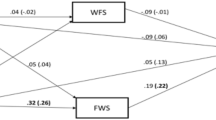Summary
Some researchers predict that work outside the home buffers the effects of childcare and marital Stressors for women by providing temporary relief from the demands of childcare and marital roles. Others argue that instead of being beneficial, work actually adds to the psychological stress generated by childcare and marital stressors by overloading working women with both employment and home-related responsibilities. This study was designed to explore the mechanisms through which work mediates the impact of childcare and marital stress on the psychological well-being of working mothers. The results indicate that work can reduce the negative effects of some forms of marital stress, but that work does not relieve or heighten stress arising from the childcare role.
Similar content being viewed by others
References
Bernard J (1971) Women and the public interest. Aldine, Chicago
Bernard J (1974) Age, sex, and feminism. Am Acad Polit Soc Sci 415: 120–137
Brogan N, Kutner N (1976) Measuring sex role orientations: a normative approach. J Marriage Family 31: 31–40
Brown G, Harris T (1978) Social origins of depression: a study of psychiatric disorder in women. Free Press, New York
Dillman D, Gallegos J, Frey J (1976) Reducing refusal rates for telephone interviews. Publ Opinion Q 40: 66–68
Gove W, Geerken M (1977) The effects of children and employment on the mental health of married men and women. Soc Forces 56: 66–76
Gove W, Tudor J (1973) Adult sex roles and mental illness. Am J Sociol 78: 812–835
Joreskog K, Sorbom D (1978) LISREL IV: analysis of linear structural relationships by the method of maximum liklihood. National Education Resources, Chicago
Kessler R, McRae J (1982) The effect of wives employment. Am Sociol Rev 47: 216–227
Krause N (1982) Married women and depressive symptoms. Soc Focus 15: 25–40
Levitt E, Lubin S (1975) Depression: concepts, controversies, and some new facts. Springer, Berlin Heidelberg New York
Motz A (1952) The role conception inventory: a tool for research in social psychology. Am Sociol Rev 17: 465–471
Parelius A (1975) Emerging sex-role attitudes, expectations, and strains among college women. J Marriage Family 37: 146–153
Parsons T (1942) Age and sex in the social structure of the United States. Am Sociol Rev 7: 604–617
Parsons T (1949) The social structure of the family. In: Anshen RN (ed) The family: its function and destiny. Harper and Row, New York
Pearlin L (1975) Sex roles and depression. In: Datan N, Ginsberg LH (eds) Life span developmental psychology: normative crisis. Academic Press, New York
Radloff L (1975) Sex differences in depression: the effects of occupation and marital status. Sex Roles 1: 249–265
Radloff L (1977) The CES-D Scale: a self-report scale for research in the general population. Appl Psychol Measurement 8: 385–401
Shaffer E, Bell R (1958) Development of a parental attitude research instrument. Child Dev 29: 338–361
Sorbom D (1979) An alternative to the methodology for analysis of covariance. In: Joreskog K (ed) Advances in factor analysis and structural equation models. ABT Books, Cambridge, MA
Sorbom D, Joreskog K (1976) COFAMM — Confirmatory Factor Analysis with Model Modification. National Educational Resources, Chicago
US Department of Labor, Bureau of Labor Statistics (1977) US working women: a databook. US Government Printing Office, Washington, DC
US Department of Labor, Women's Bureau (1975) 1975 Handbook of women workers. US Government Printing Office, Washington, DC
Warr P, Parry G (1982a) Paid employment and women's psychological well-being. Psychol Bull 91: 498–516
Warr P, Parry G (1982b) Depressed mood in working-class mothers with and without paid employment. Soc Psychiatry 17: 161–165
Weissman M, Sholomskas D, Pottenger M, Prusoff B, Locke B (1977) Assessing depressive symptoms in five psychiatric populations: a validation study. Am J Epidemiol 106: 203–214
Author information
Authors and Affiliations
Additional information
Work on the research reported in this paper was done while the author was a fellow in the Postdoctoral Training Program in Measurement NIMH Grant No. PHS T32 MH 15789-02.
Rights and permissions
About this article
Cite this article
Krause, N. Employment outside the home and women's psychological well-being. Soc Psychiatry 19, 41–48 (1983). https://doi.org/10.1007/BF00583860
Accepted:
Issue Date:
DOI: https://doi.org/10.1007/BF00583860




